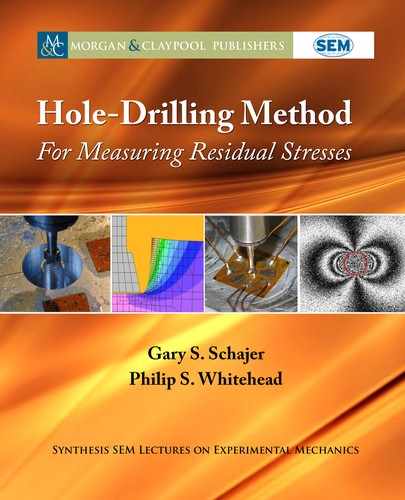
158 7. OPTICAL TECHNIQUES
* * * * * *
* * * * * *
* * * * * *
* * * * * *
* * * * * *
* * * * * *
* * *
* * *
* * *
* * *
* * *
* * *
* * *
* * *
* * *
* * *
* * *
* * *
w
1
w
2
w
3
w
4
w
5
w
6
w
7
w
8
w
9
δ
x1
δ
x2
δ
x3
δ
x4
δ
x5
δ
x6
δ
y1
δ
y2
δ
y3
δ
y4
δ
y5
δ
y6
=
Figure 7.13: Schematic diagram of the structure of Equation (7.1) for a 2-axis measurement.
With care about the handling of the numerical data, solution of Equation (7.2) for the
2-axis case is not very much more burdensome than the single-axis case, just over twice the
total computation time. e extra measurement and computation effort brings two significant
benefits.
1. Isotropic measurement sensitivity. Residual stresses in all directions are evaluated with
the same precision. In contrast, evaluation of the residual stress in the perpendicular direc-
tion of a single-axis measurement is governed by Poisson’s ratio and its precision is reduced
by that factor.
2. Greater expected accuracy. A two-axis measurement uses 2N data to determine nine
quantities, while a single-axis measurement uses N data to determine six quantities. A
2-axis measurement can therefore be expected to produce a more accurate result because
it has available one and a half times the data per evaluated quantity.
7.7 COMPUTATION OF NON-UNIFORM RESIDUAL
STRESSES
e calculation procedure described in the previous section is effective to determine hole-drilling
residual stresses for the case where the stresses are uniform within the hole depth. It is the full-
field optical equivalent of doing a strain gauge uniform stress calculation of the type described
in Chapter 5, Section 5.2. However, it most commonly happens that the residual stresses in
a material are not uniform with depth from the specimen surface. e approach required to
evaluate the variation of stress with depth from full-field optical data parallels that required for
strain gauge data, described in Section 5.6. In summary, the required procedure is as follows.
7.7. COMPUTATION OF NON-UNIFORM RESIDUAL STRESSES 159
1. Drill a hole in a series of small depth increments down to the final desired depth.
2. Make an optical measurement of the surface around the hole after each hole depth incre-
ment has been completed.
3. Discretize the residual stress profile into a series of steps based on the hole depth incre-
ments (see Figure 5.7).
4. Use the Integral Method to determine those stresses from the combination of all the mea-
sured data.
In concept, the procedure for implementing the Integral Method with full-field optical
data substitutes Equation (7.1) for the analogous strain gauge Equations (5.18). Figure 5.8 in
Chapter 5 schematically illustrates the computational concept of the Integral Method. e dia-
grams represent the responses of the material around a drilled hole to the residual stresses within
various hole depth increments in holes of various depths. e measured response at a given hole
depth is the sum of all the responses along the row corresponding to that hole depth. is ar-
rangement can be expressed directly in matrix format, which for strain gauge calculations gives
the lower triangular matrices
N
a and
N
b described in Chapter 5.
For strain gauge measurements, single-strain values are measured to identify each of the
stress components P; Q, and T . us, a single number represents each loading case in Figure 5.8
within the matrices
N
a and
N
b. However, when making full-field optical measurements, the num-
ber of measured displacement values for each loading case is in the 10
4
–10
6
range. Under these
circumstances, each number in matrices
N
a and
N
b is replaced by the much larger grouping shown
in Figure 7.13 (or a reduced version for single-axis measurements) within a much larger com-
bined G matrix. Figure 7.14 schematically illustrates the resulting matrix equation, where the
rectangles represent entire matrices and vectors from Figure 7.13, each corresponding to its as-
sociated load case in Figure 5.8.
e G matrix in Figure 7.14 is very large, so significant care is required to handle it ef-
fectively. Fortunately, the corresponding G
T
G matrix for Equation (7.2) is much smaller, with
dimensions 9n 9n (or 6n 6n for a single-axis measurement), where n is the number of hole
depth increments used. is is a much more tractable size and is comfortably handled by mod-
ern computers. e various columns in the G matrix and ı vector, respectively, represent the
theoretical and measured full-field images for the various load cases. ese do not all need to be
held in computer memory at the same time, thus avoiding the need to store the entire G matrix
simultaneously. Instead, the various images can be loaded a few at a time and the G
T
G matrix
progressively assembled by incrementing the dot products of corresponding parts of columns.
Of note is that the parts of the G matrix corresponding to the artifacts w
4
–w
9
are the same at
each hole depth, so one copy of these numbers suffices for all hole depths. On a conventional
2017 desk computer, the computation time for a 16-increment single-axis measurement with
100,000 active pixels was approximately one minute. e required computation time varies ap-
proximately with the square of the number of hole depth increments and proportionally to the
..................Content has been hidden....................
You can't read the all page of ebook, please click here login for view all page.
